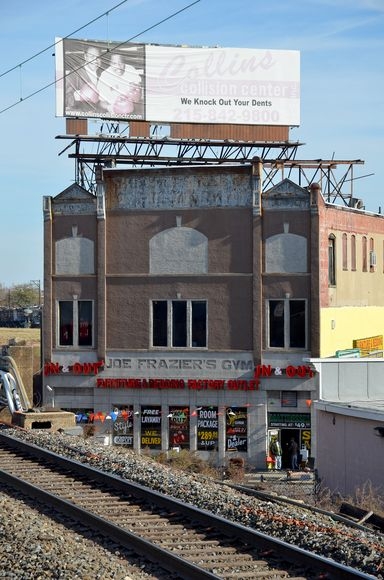Temple Architecture team fights to save Joe Frazier's Gym
Tens of thousands of Philadelphians drove past the dull, three-story brick building at the corner of North Broad and Glenwood last summer without noticing the "For Sale" signs. But Dennis Playdon, an adjunct professor of architecture at Temple's Tyler School of Art, understood what they meant — Joe Frazier's Gym, a Philadelphia icon, was in danger.
Last month, a year-long effort led by Playdon and his students to save Joe Frazier's Gym earned the structure a spot on the National Trust for Historic Preservation's list of America's 11 Most Endangered Historic Places. The National Trust now lists the gym as a National Treasure.
The announcement in June brought preservationists, reporters, city officials, local residents and the late boxing legend's friends and family to Temple's new Architecture Building. It was a much-needed boost of attention for a structure that had been largely ignored since the gym closed its doors in 2008 and a discount furniture store became the building's primary tenant. But with the site up for sale once again, publicity may not be enough to save Joe Frazier's Gym. Two Temple students (supported in part by the National Trust) have nearly completed a nomination to get the structure listed on Philadelphia Historic Commission's Philadelphia Register of Historic Places. If they're successful, the building's present or future owners will be prevented from touching the outside of the building for any purpose other than preservation.
"Sites like this deserve to be preserved because of their cultural content," Playdon said. "The building has little architectural merit, but it's worth preserving because of Joe Frazier and what he did there. He was not just one of the great boxers of his time. He was a kind of surrogate father to many people in the community; he helped them, guided them, advised them."
The Temple campaign to save Joe Frazier's Gym began shortly after Playdon noticed that the site was for sale in the summer of 2011. He was about to begin teaching a new course in the fall, "Introduction to Architectural Preservation," and decided to incorporate the site in his syllabus. Playdon's students began to dig into the building's past, uncovering the structure's early history as a sash and blind manufacturing site and a lumber warehouse before Joe Frazier's management company, Cloverlay, purchased the site in the late 1960s and converted it into a gym.
Class assignments began to evolve into a real-world preservation campaign. Temple undergraduates — architecture majors Matt Ferris and Evan Weiss and history major Laura Schmitt-Hall — wrote a nomination that earned Joe Frazier's Gym a spot on the Preservation Alliance for Greater Philadelphia's Endangered Properties List in late 2011 (it was a Philadelphia Inquirer article on the Preservation Alliance list that got the attention of the National Trust). Two other Tyler architecture majors, Ann Dinh and Michael Baker, took on a nomination for a spot on the Philadelphia Register of Historic Places — and, the students hope, true protection for a homely building that they've learned to love.
"It has been really exciting and I've really learned a lot about historic preservation," said Dinh, a senior architecture major. "There are so many important buildings in North Philadelphia and a lot of them are close to Temple — like the Divine Lorraine and the Uptown Theater — but a lot of them are really dilapidated."
The cultural richness and underdog status of Joe Frazier's Gym is part of what attracted the National Trust, which has been leading an effort to preserve more than just fancy old homes in affluent neighborhoods.
"There's an opportunity here to say that some places are important, even if they're not grand," Stephanie Meeks, president of the National Trust for Historic Preservation, told the Los Angeles Times. "History isn't always glamorous."
The Temple team's work is far from done. This fall, Playdon will teach "Introduction to Architectural Preservation" again (Tyler's Architecture Department has one of the nation's few undergraduate architectural preservation programs), and his students will tackle new and more ambitious projects, including measuring and documenting the building, creating a 3-D digital model of the structure and beginning to assemble a multimedia web site.
